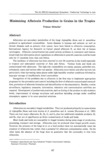Minimizing Aflatoxin Production in Grains in the Tropics
JIRCAS international symposium series
| ISSN | 13406108 |
|---|---|
| 書誌レコードID(総合目録DB) | AA1100908X |

本文フルテキスト
intlsymp-7_87-94.pdf200.68 KB
Aflatoxins are secondary metabolites of the fungi Aspergillus flavus and A. parasiticus produced in agricultural commodities. Acute diseases in humans and animals, as well as chronic diseases such as primary liver cancer, have been linked to aflatoxin consumption. International Agency for Research on·Cancer placed aflatoxin B1 on their list of human carcinogens. Aflatoxin contamination has posed serious problems in commerce and international trade but information about regulations on aflatoxins in some 60 countries could be found only for 17 countries from Asia and Africa.
The incidence of aflatoxins has been reported in over 50 countries in the world especially in tropical and subtropical countries of Asia and Africa. Various foods and feeds are contaminated with aflatoxins. The high-risk commodities are maize, peanuts, parboiled rice, cottonseed, copra and various other nut species. Aflatoxins occur before and after harvest, but particularly when harvesting takes places under high humidity weather conditions followed by improper storage of insufficiently dried commodities.
Recognition of the problems due to aflatoxin is the first step to implement appropriate programs for the prevention and control, including the flow of aflatoxin-contaminated commodities, prevention of aflatoxin formation and detoxification or decontamination. Besides, routine surveillance, regulatory measures, information, education and communication activities are required. Development of postharvest practices, such as drying of the produce to safe moisture levels, improvement of storage structures and practices including storage under modified atmosphere, appear to be more practical solutions.
The incidence of aflatoxins has been reported in over 50 countries in the world especially in tropical and subtropical countries of Asia and Africa. Various foods and feeds are contaminated with aflatoxins. The high-risk commodities are maize, peanuts, parboiled rice, cottonseed, copra and various other nut species. Aflatoxins occur before and after harvest, but particularly when harvesting takes places under high humidity weather conditions followed by improper storage of insufficiently dried commodities.
Recognition of the problems due to aflatoxin is the first step to implement appropriate programs for the prevention and control, including the flow of aflatoxin-contaminated commodities, prevention of aflatoxin formation and detoxification or decontamination. Besides, routine surveillance, regulatory measures, information, education and communication activities are required. Development of postharvest practices, such as drying of the produce to safe moisture levels, improvement of storage structures and practices including storage under modified atmosphere, appear to be more practical solutions.
| 作成者 | Prisnar Siriacha |
|---|---|
| 公開者 | Japan International Research Center for Agricultural Sciences |
| オンライン掲載日 | |
| 号 | 7 |
| 開始ページ | 87 |
| 終了ページ | 94 |
| 言語 | eng |
